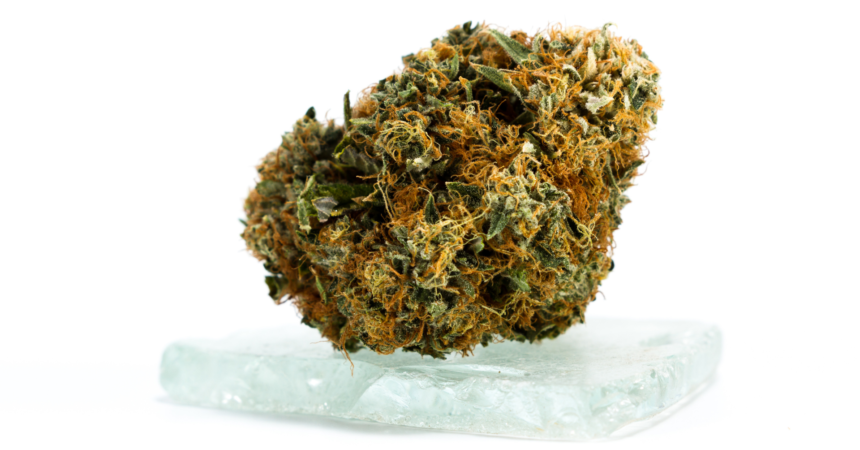3 things structure can tell you about the quality of your cannabis

By Allison Cohn
A flower’s structure is a very obvious way to learn about the environmental factors that have affected it throughout its lifecycle, for better or worse. By definition, cannabis structure is its physical density, dryness and bract-to-leaf ratio. Happy, healthy cannabis will be both dense and pliable, without being damp or wet. During cannabis grading, structure is categorized as a qualitative data element, where shape, size and moisture content are observed and analyzed. Loose and airy flower that contains a high percentage of “leaf” generally scores lower, while dense, fluffy and shapely flower scores higher. Structure can be negatively influenced by pests or fungus, which can cause defects resulting in the lower grade.
Structure can reveal information about growing conditions, what sort of nutrients or stresses it was exposed to and whether or not the flower was cured and stored well. Trim quality can also greatly affect the flower’s structure, which reflects on the curing processes, and then there are the ratios of A-flower to B-flower to trim or “shake” which, when evaluated, can tell a lot about how the flower was grown as well.
1. WHAT WERE THE GROWING CONDITIONS?
There are the different flower types, as categorized by size. Whether or not it’s A-Flower or B-Flower can tell you about its light exposure while growing. A-Flower refers to the larger flowers that grow towards the top of the plant and are therefore exposed to the most sunlight. B-flower, which grows towards the bottom of the plant and consists of smaller flowers, is generally exposed to less light. The cannabinoid content ought to be similar on both types of flowers that come from the same plant, but their size can tell you about which part of the plant they grew on.
Furthermore, the ratio of A-Flower to B-Flower can usually tell you whether the plant was grown in or outdoors. Indoor plants tend to have a high A-Flower ratio because of their controlled environment, while cannabis grown outdoors is exposed to the elements and natural sunlight. Cannabis comprised of 30% or more of “fan leaf,” the remaining small leaves and crumbled flowers found at the bottom of a container of cannabis flowers, tend to score poorly.
2. WAS THE FLOWER PROPERLY CURED?
During the plant’s curing and drying processes, it typically loses up to about 80% of its water weight. Getting the perfect moisture content in a flower will achieve an ideal structure, but it’s tricky to accomplish. If the flower gets too dry, it will crumble apart when you touch it and ultimately lose its potent fragrance, negatively affecting its flavor profile, making it harsh to smoke and earning it a low grading score. Perfectly cured cannabis will have just the right squish to it, retaining its integrity when gently squeezed and bouncing back to its original form.
Proper trimming technique can really affect the flower’s structure. While the trimming technique shouldn’t be actually shaping the flower, it can certainly show off a flower’s good attributes and downplay defects -- but you can never fool the graders. If the flower had mold that was then trimmed away, they’ll very likely still notice, and any excessive leaves or awkward stems leftover after trimming can result in a lower score.
3. WAS THE FLOWER STORED PROPERLY?
Properly storing cannabis is very important. If the plant is exposed to light, air or moisture, it may develop defects or become dried out, discolored and potentially lose its desired flavors. Cannabis is also very sensitive to extreme temperatures and humidity.
Oxidation can cause the flower to dry out, becoming fragile and airy, ultimately deteriorating its structure. On the other hand, exposure to moisture or humidity could cause the flower to become too dense, which may be a sign that it’s growing mold inside. If flower appears dry, crumbly, loose or mildewed, this could have a direct correlation with improper storage techniques and it will receive a lower grade.
QUALITY STRUCTURE MEANS QUALITY FLOWER
Bud with good structure is like a sharp dressed man in a tailored suit. You are impressed with the fit, the details and the general aesthetic. The flowers demonstrate a good size, squish and shape to them. It won’t crumble to dust when you try to pack the pipe. And it’s free of any defects or creeping mold. Its bract-to-leaf ratio is balanced, leaning towards more bract, and it’s moist, but not impossible to spark up. All of these attributes signify a healthy flower, one that you should be excited to utilize and one that likely boasts a high grade.
Read more in this series:
3 things aroma can tell you about the quality of your cannabis
3 things color can tell you about the quality of your cannabis
3 things trichomes can tell you about the quality of your cannabis

Allison Cohn loves gold spray paint and nonsense. She also has a very difficult time sitting still and keeping quiet. She can often be found dancing like a fool when she isn’t hiding out in her mountain lair or gallivanting around the globe.
